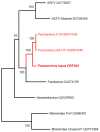An Update on Eukaryotic Viruses Revived from Ancient Permafrost
- PMID:36851778
- PMCID: PMC9958942
- DOI: 10.3390/v15020564
An Update on Eukaryotic Viruses Revived from Ancient Permafrost
Abstract
One quarter of the Northern hemisphere is underlain by permanently frozen ground, referred to as permafrost. Due to climate warming, irreversibly thawing permafrost is releasing organic matter frozen for up to a million years, most of which decomposes into carbon dioxide and methane, further enhancing the greenhouse effect. Part of this organic matter also consists of revived cellular microbes (prokaryotes, unicellular eukaryotes) as well as viruses that have remained dormant since prehistorical times. While the literature abounds on descriptions of the rich and diverse prokaryotic microbiomes found in permafrost, no additional report about "live" viruses have been published since the two original studies describing pithovirus (in 2014) and mollivirus (in 2015). This wrongly suggests that such occurrences are rare and that "zombie viruses" are not a public health threat. To restore an appreciation closer to reality, we report the preliminary characterizations of 13 new viruses isolated from seven different ancient Siberian permafrost samples, one from the Lena river and one from Kamchatka cryosol. As expected from the host specificity imposed by our protocol, these viruses belong to five different clades infectingAcanthamoeba spp. but not previously revived from permafrost: Pandoravirus, Cedratvirus, Megavirus, and Pacmanvirus, in addition to a new Pithovirus strain.
Keywords: Acanthamoeba; Kamchatka; Pleistocene; Siberia; giant virus; permafrost.
Conflict of interest statement
The authors declare no conflict of interest.
Figures



References
- IPCC . In: 2022: Climate Change 2022: Impacts, Adaptation and Vulnerability. Contribution of Working Group II to the Sixth Assessment Report of the Intergovernmental Panel on Climate Change. Pörtner H.-O., Roberts D.C., Tignor M., Poloczanska E.S., Mintenbeck K., Alegría A., Craig M., Langsdorf S., Löschke S., Möller V., Okem A., Rama B., editors. Cambridge University Press; Cambridge, UK: New York, NY, USA: 2022. 3056p. - DOI
- Rantanen M., Karpechko A.Y., Lipponen A., Nordling K., Hyvärinen O., Ruosteenoja K., Vihma T., Laaksonen A. The Arctic has warmed nearly four times faster than the globe since 1979. Commun. Earth Environ. 2022;3:168. doi: 10.1038/s43247-022-00498-3. - DOI
Publication types
MeSH terms
Substances
LinkOut - more resources
Full Text Sources
Research Materials
Miscellaneous
